lexus LFA 2012 Technical Information / LEXUS 2012 LFA: INSIDE THE LFA
Manufacturer: LEXUS, Model Year: 2012, Model line: LFA, Model: Lexus LFA 2012Pages: 128, PDF Size: 5.91 MB
Page 21 of 128
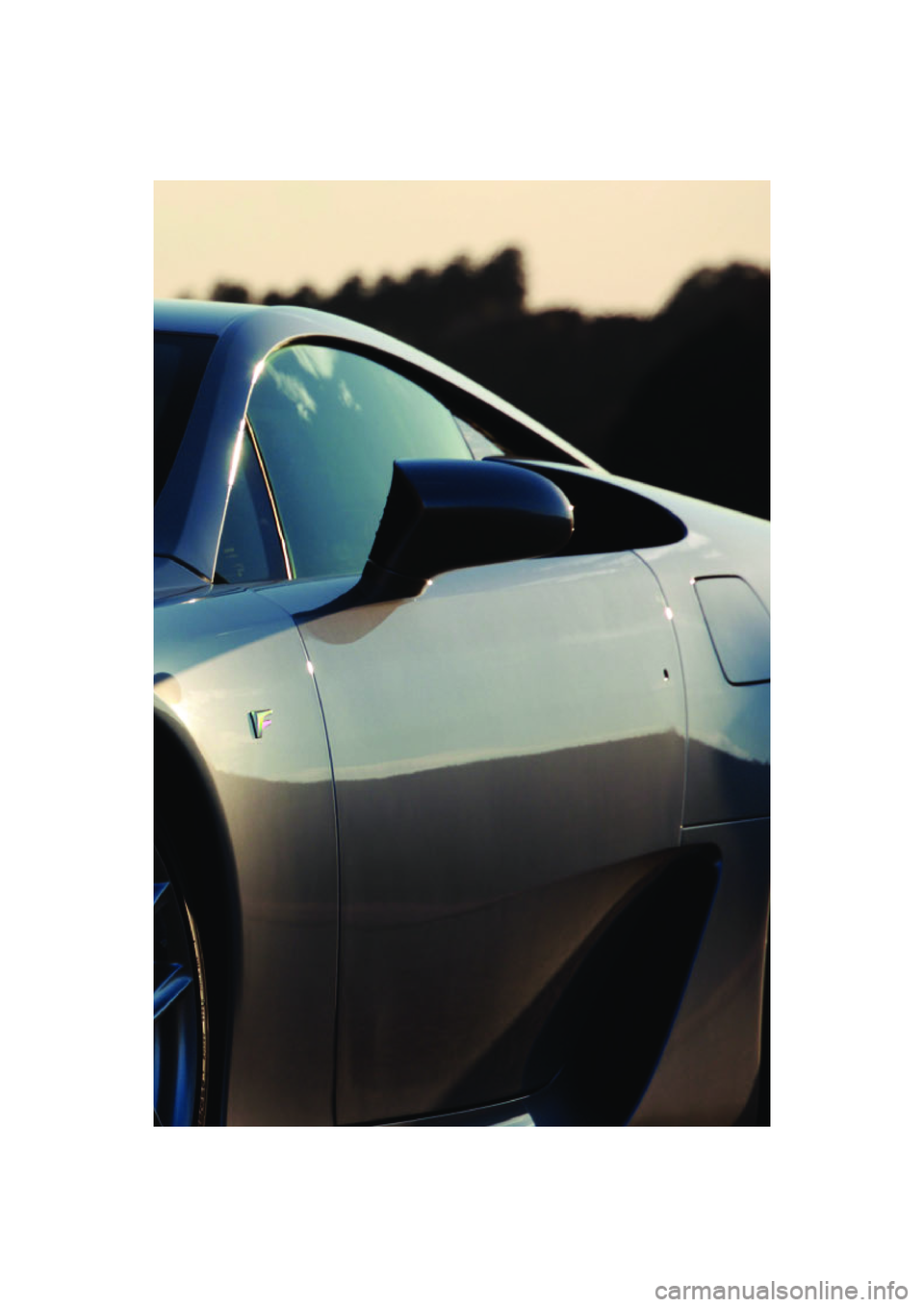
Page 22 of 128
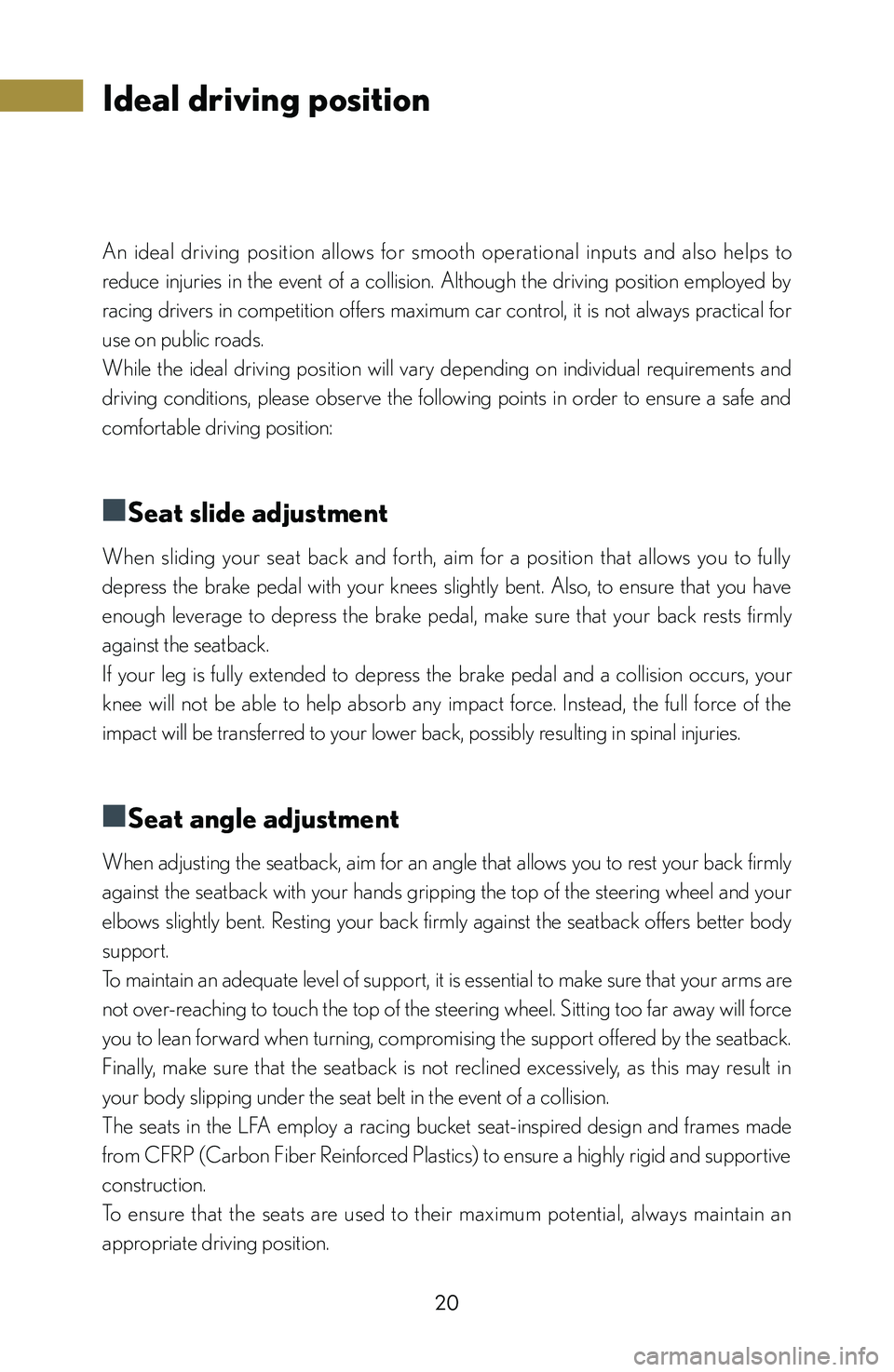
20
Ideal driving position
An ideal driving position allows for smooth operational inputs and also helps to
reduce injuries in the event of a collision. Although the driving position employed by
racing drivers in competition offers maximum car control, it is not always practical for
use on public roads.
While the ideal driving position will vary depending on individual requirements and
driving conditions, please observe the following points in order to ensure a safe and
comfortable driving position:
■
■Seat slide adjustment
When sliding your seat back and forth, aim for a position that allows you to fully
depress the brake pedal with your knees slightly bent. Also, to ensure that you have
enough leverage to depress the brake pedal, make sure that your back rests firmly
against the seatback.
If your leg is fully extended to depress the brake pedal and a collision occurs, your
knee will not be able to help absorb any impact force. Instead, the full force of the
impact will be transferred to your lower back, possibly resulting in spinal injuries.
■
■Seat angle adjustment
When adjusting the seatback, aim for an angle that allows you to rest your back firmly
against the seatback with your hands gripping the top of the steering wheel and your
elbows slightly bent. Resting your back firmly against the seatback offers better body
support.
To maintain an adequate level of support, it is essential to make sure that your arms are
not over-reaching to touch the top of the steering wheel. Sitting too far away will force
you to lean forward when turning, compromising the support offered by the seatback.
Finally, make sure that the seatback is not reclined excessively, as this may result in
your body slipping under the seat belt in the event of a collision.
The seats in the LFA employ a racing bucket seat-inspired design and frames made
from CFRP (Carbon Fiber Reinforced Plastics) to ensure a highly rigid and supportive
construction.
To ensure that the seats are used to their maximum potential, always maintain an
appropriate driving position.
Page 23 of 128
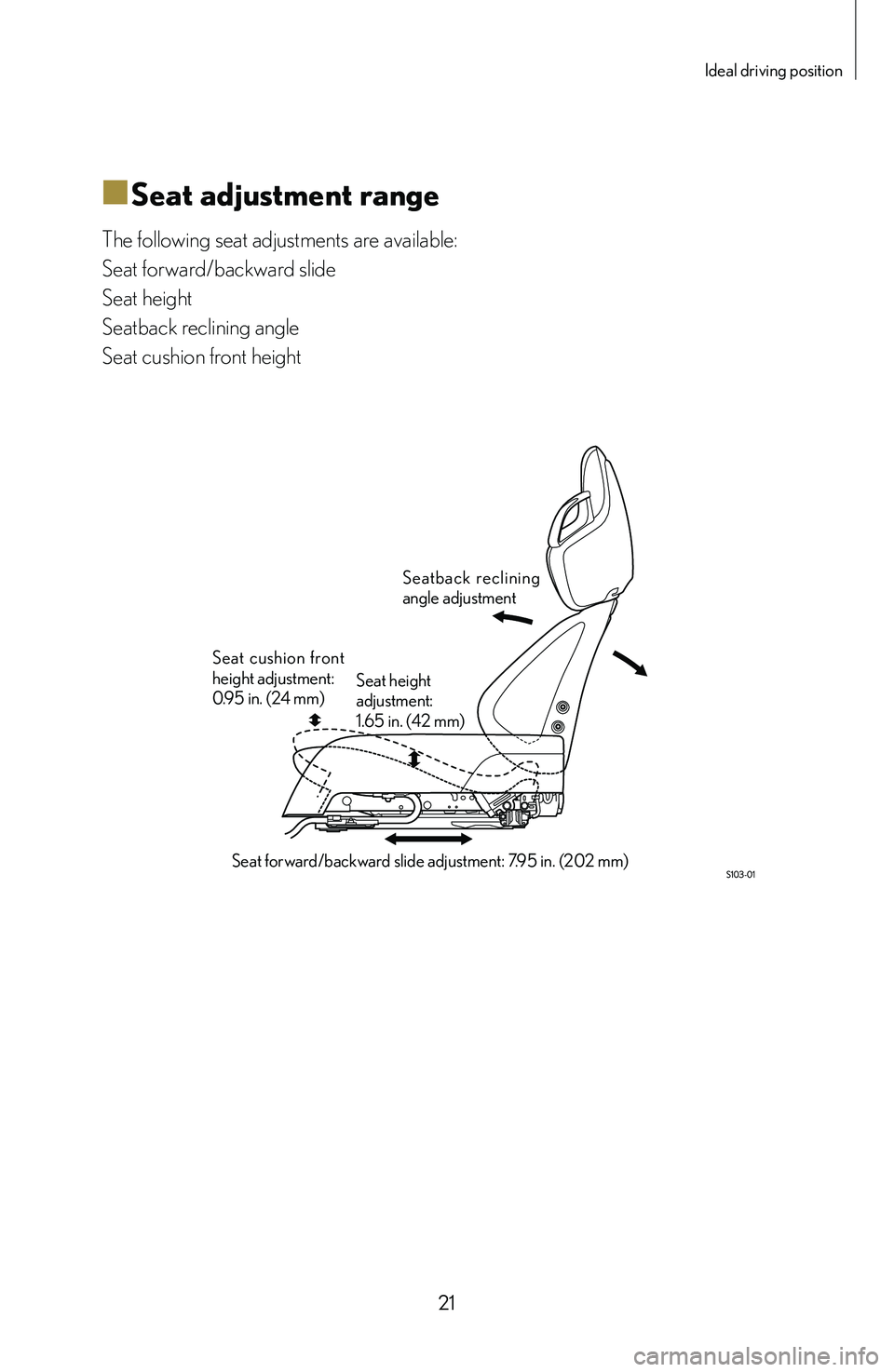
21
Ideal driving position
■
■Seat adjustment range
The following seat adjustments are available:
Seat forward/backward slide
Seat height
Seatback reclining angle
Seat cushion front height
Seatback reclining
angle adjustment
Seat cushion front
height adjustment:
0.95 in. (24 mm)
Seat forward/backward slide adjustment: 7.95 in. (202 mm) Seat height
adjustment:
1.65 in. (42 mm)
Page 24 of 128
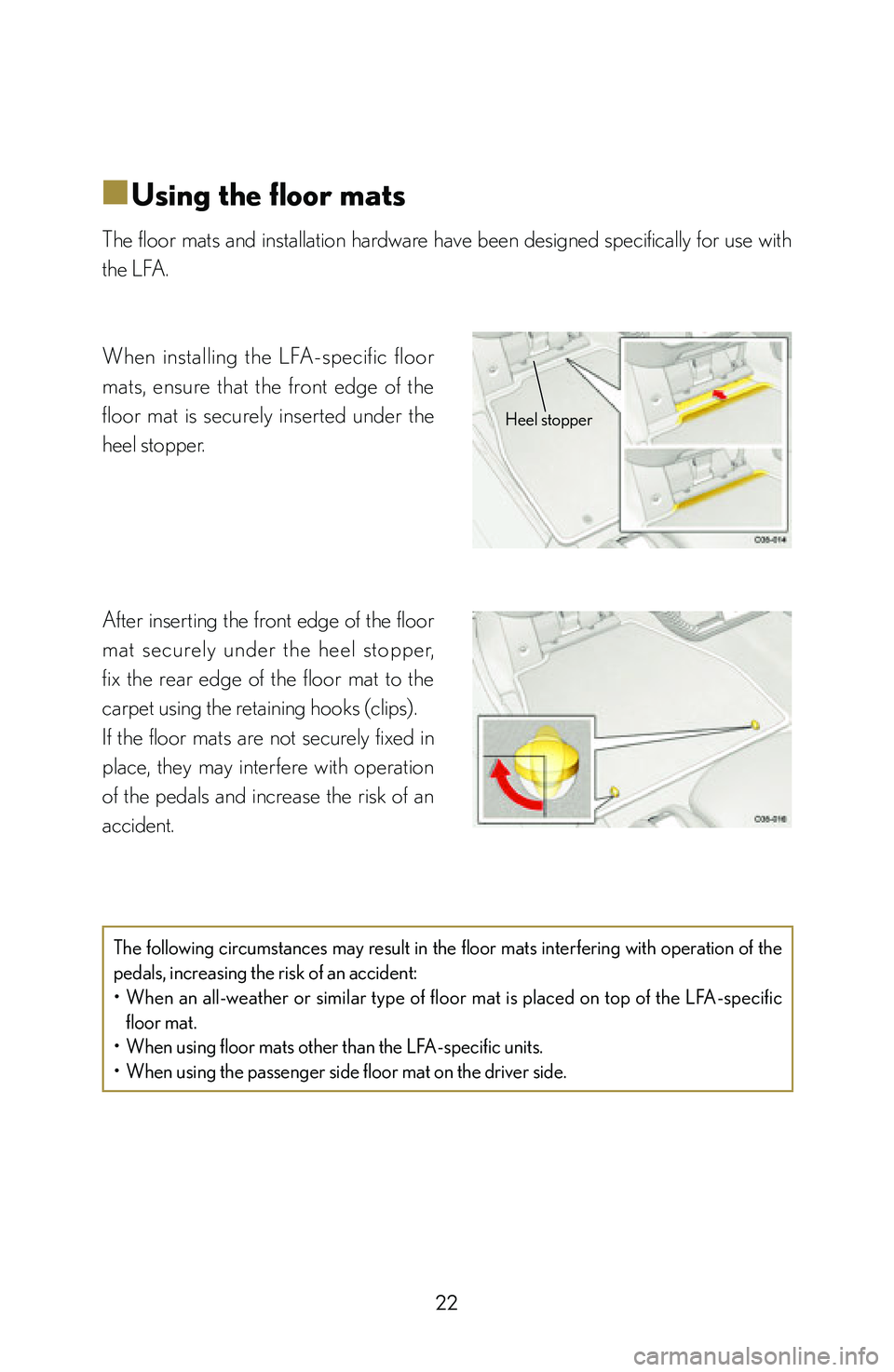
22
■
■Using the floor mats
The floor mats and installation hardware have been designed specifically for use with
the LFA.
When installing the LFA-specific floor
mats, ensure that the front edge of the
floor mat is securely inserted under the
heel stopper.
After inserting the front edge of the floor
mat securely under the heel stopper,
fix the rear edge of the floor mat to the
carpet using the retaining hooks (clips).
If the floor mats are not securely fixed in
place, they may interfere with operation
of the pedals and increase the risk of an
accident.
The following circumstances may result in the floor mats interfering with operation of the
pedals, increasing the risk of an accident:
• When an all-weather or similar type of floor mat is placed on top of the LFA-specific
floor mat.
• When using floor mats other than the LFA-specific units.
• When using the passenger side floor mat on the driver side.
Heel stopper
Page 25 of 128
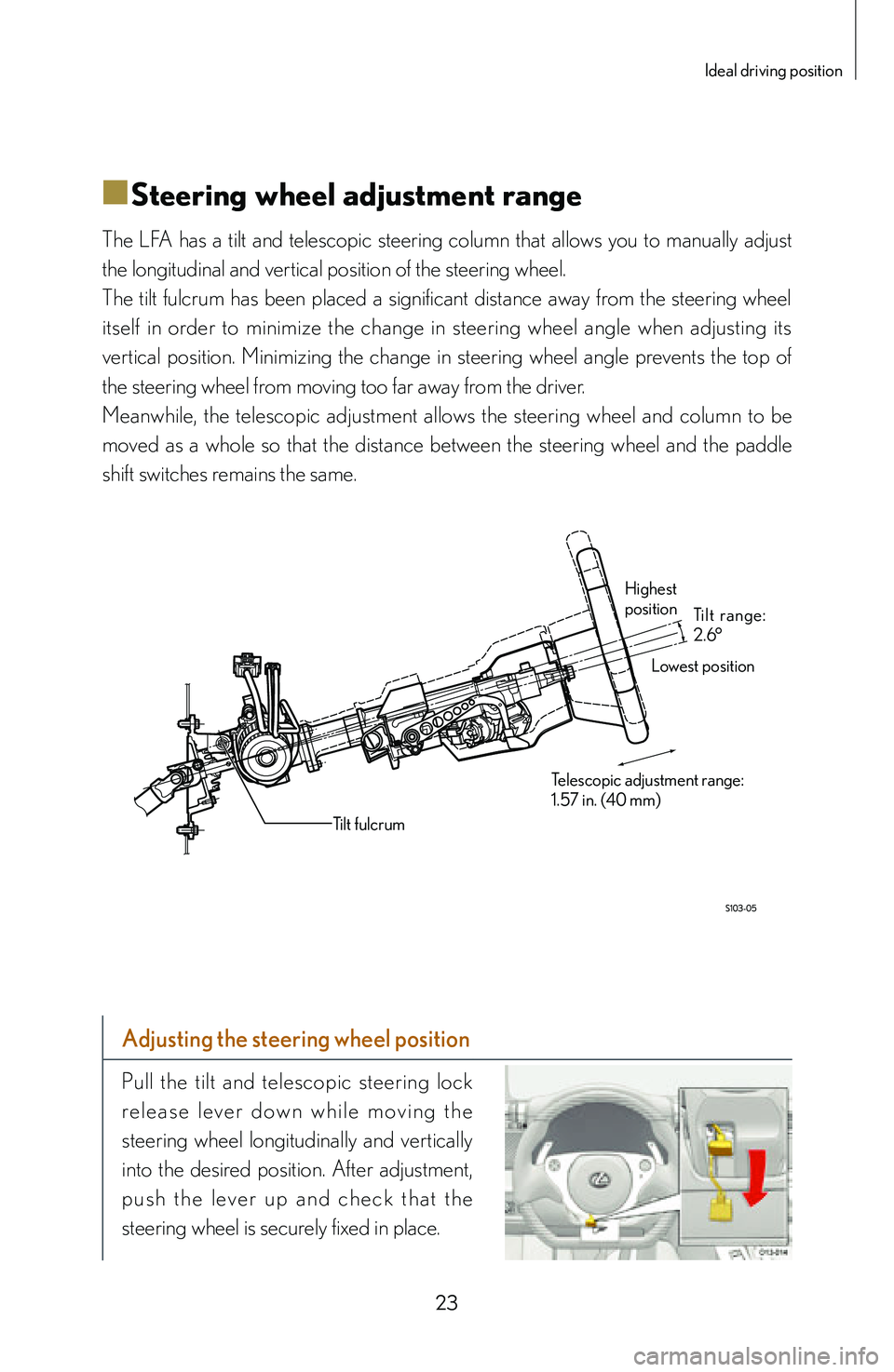
23
Ideal driving position
■
■Steering wheel adjustment range
The LFA has a tilt and telescopic steering column that allows you to manually adjust
the longitudinal and vertical position of the steering wheel.
The tilt fulcrum has been placed a significant distance away from the steering wheel
itself in order to minimize the change in steering wheel angle when adjusting its
vertical position. Minimizing the change in steering wheel angle prevents the top of
the steering wheel from moving too far away from the driver.
Meanwhile, the telescopic adjustment allows the steering wheel and column to be
moved as a whole so that the distance between the steering wheel and the paddle
shift switches remains the same.
Highest
position
Lowest position
Telescopic adjustment range:
1.57 in. (40 mm) Tilt range:
2.6°
Tilt fulcrum
Adjusting the steering wheel position
Pull the tilt and telescopic steering lock
r e l e a s e l e v e r d o w n w h i l e m o v i n g t h e
steering wheel longitudinally and vertically
into the desired position. After adjustment,
p u s h t h e l eve r u p a n d c h e c k t h a t t h e
steering wheel is securely fixed in place.
Page 26 of 128
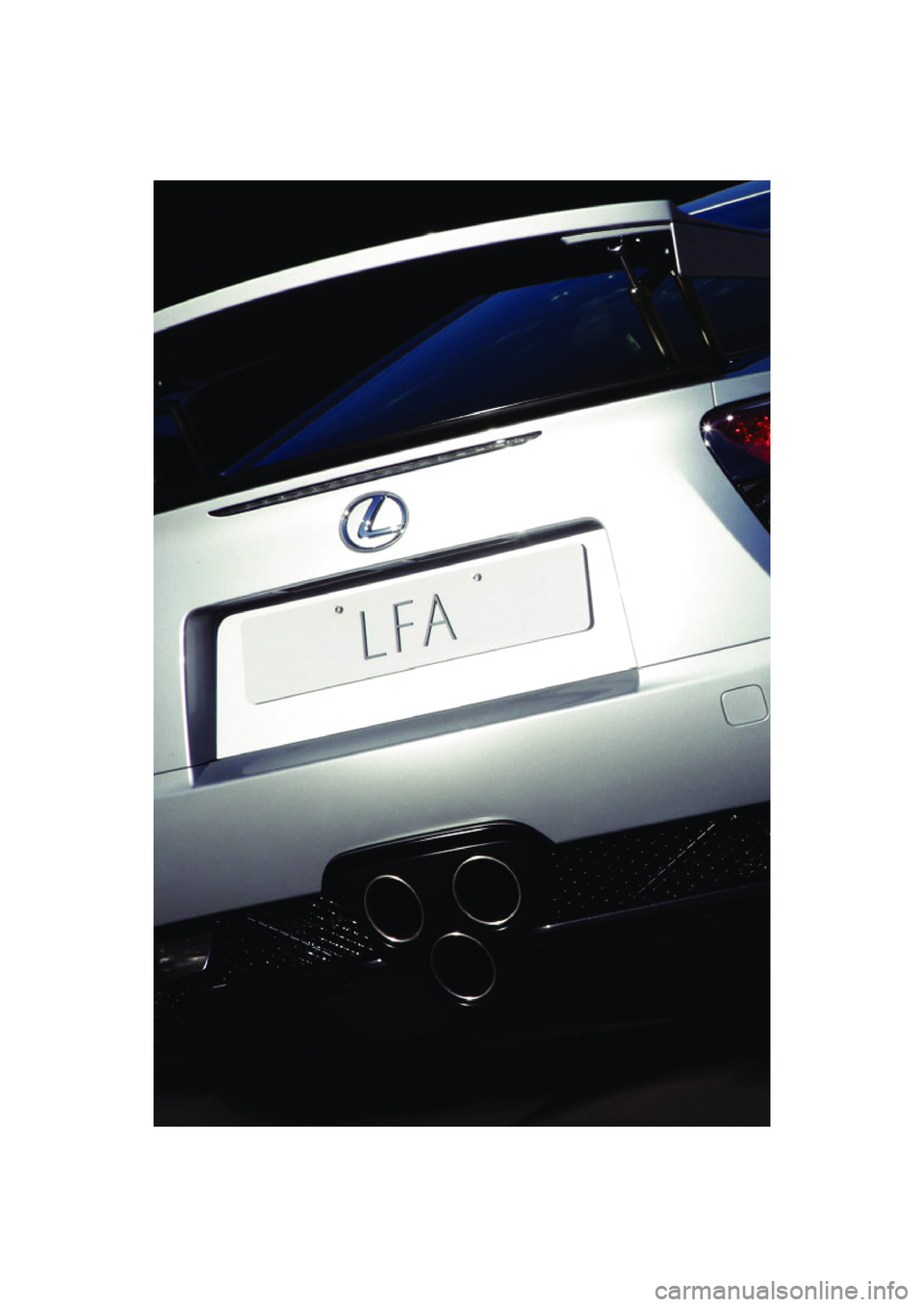
Page 27 of 128

Page 28 of 128
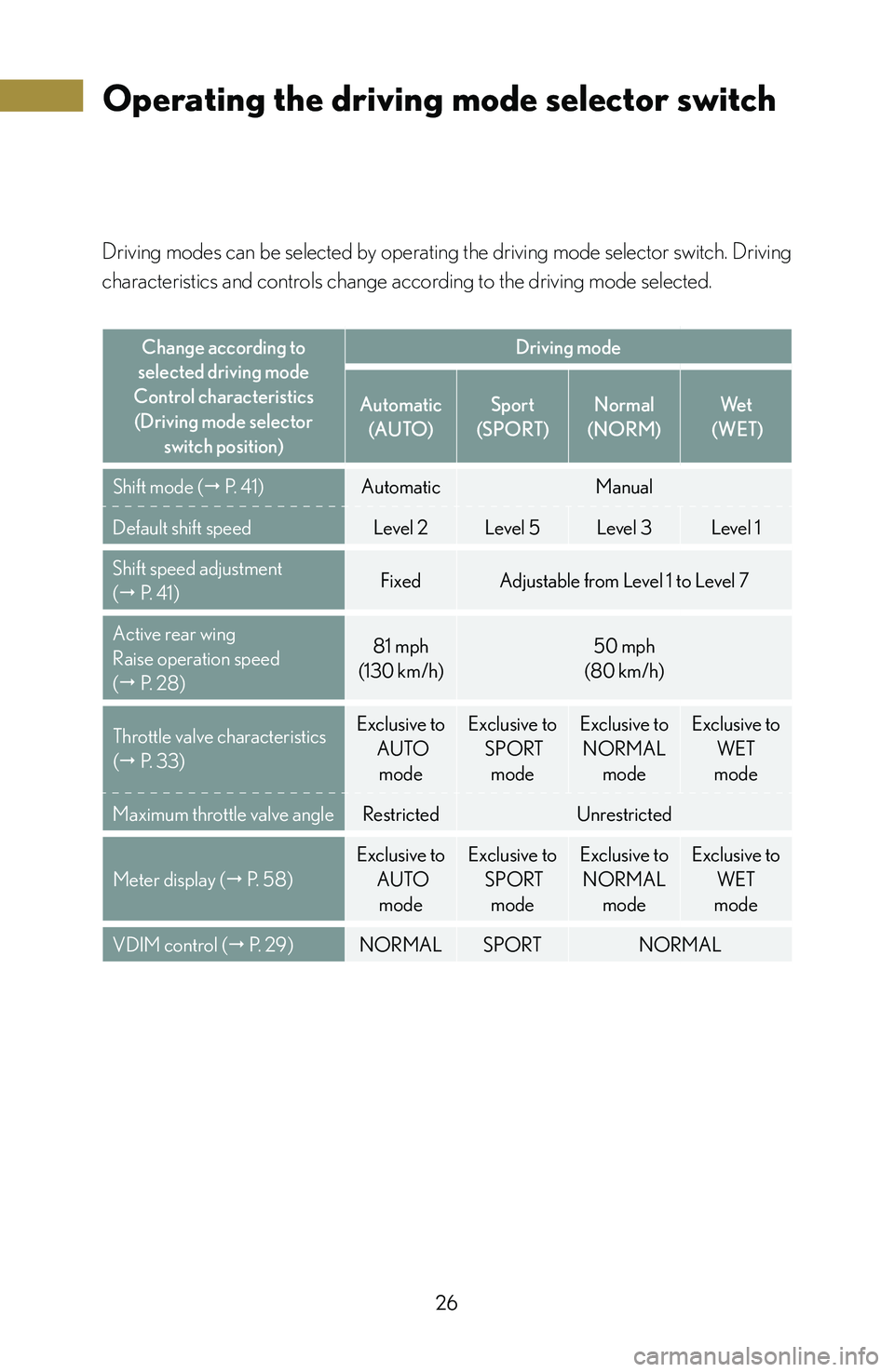
26
Operating the driving mode selector switch
Driving modes can be selected by operating the driving mode selector switch. Driving
characteristics and controls change according to the driving mode selected.
Change according to
selected driving mode
Control characteristics
(Driving mode selector
switch position)
Driving mode
Automatic
(AUTO)
Sport
(SPORT)
Normal
(NORM)Wet (WET)
Shift mode (" P. 41)
Automatic Manual
Default shift speed Level 2Level 5 Level 3 Level 1
Shift speed adjustment
(
" P. 41) Fixed
Adjustable from Level 1 to Level 7
Active rear wing
Raise operation speed
(
" P. 28) 81 mph
(130 km/h) 50 mph
(80 km/h)
Throttle valve characteristics
(
" P. 33) Exclusive to
AUTO mode Exclusive to
SPORT mode Exclusive to
NORMAL mode Exclusive to
WET
mode
Maximum throttle valve angle Restricted Unrestricted
Meter display (
" P. 58) Exclusive to
AUTO mode Exclusive to
SPORT mode Exclusive to
NORMAL mode Exclusive to
WET
mode
VDIM control (
" P. 29) NORMAL SPORT NORMAL
Page 29 of 128
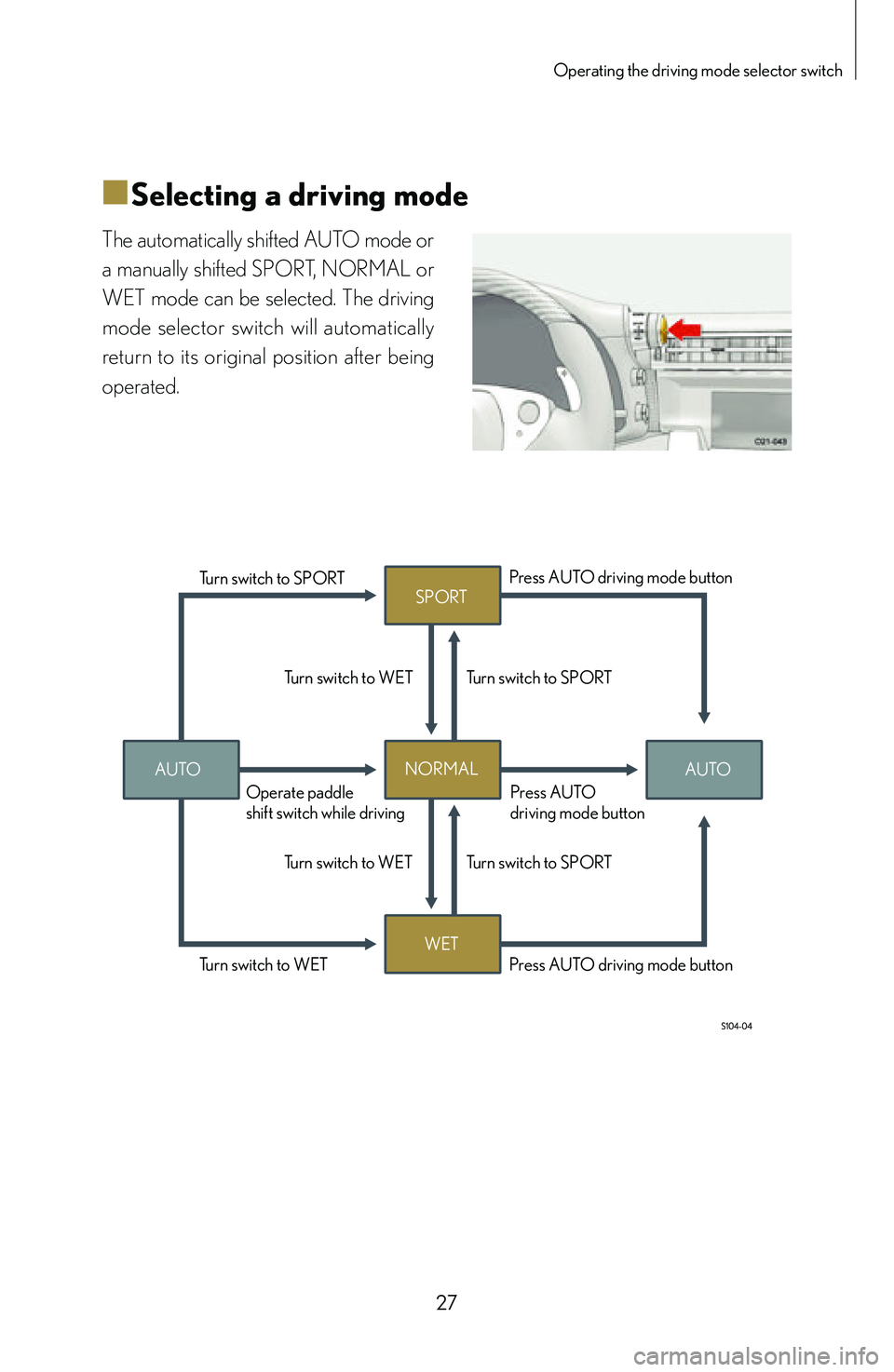
27
Operating the driving mode selector switch
■
■Selecting a driving mode
The automatically shifted AUTO mode or
a manually shifted SPORT, NORMAL or
WET mode can be selected. The driving
mode selector switch will automatically
return to its original position after being
operated.
AUTO NORMAL
AUTO
SPORT
WET
Turn switch to SPORT
Operate paddle
shift switch while driving
Turn switch to WET Press AUTO driving mode buttonPress AUTO
driving mode button
Turn switch to WET
Turn switch to WET Turn switch to SPORT
Turn switch to SPORTPress AUTO driving mode button
Page 30 of 128
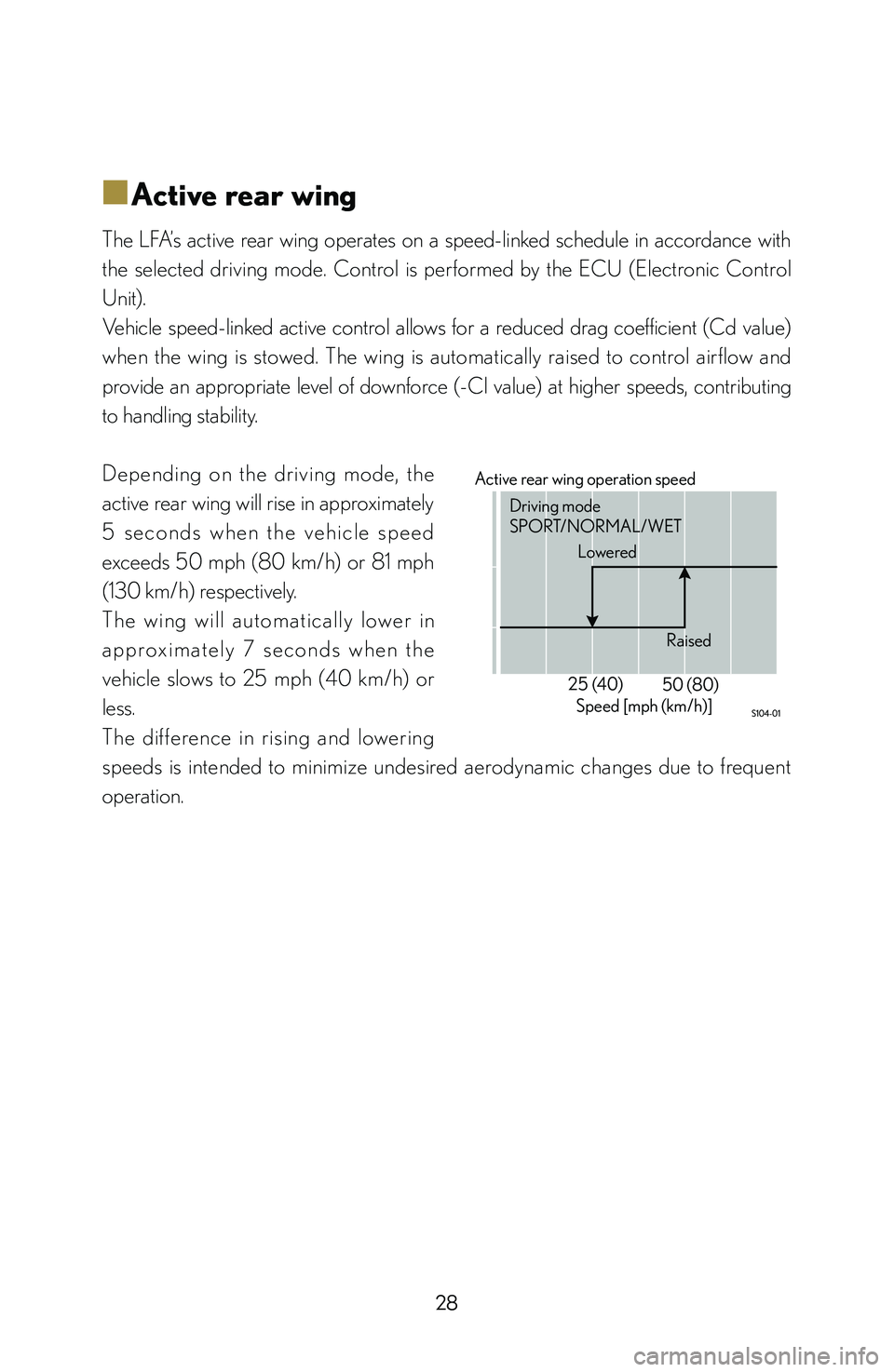
28
■
■Active rear wing
The LFA’s active rear wing operates on a speed-linked schedule in accordance with
the selected driving mode. Control is performed by the ECU (Electronic Control
Unit).
Vehicle speed-linked active control allows for a reduced drag coefficient (Cd value)
when the wing is stowed. The wing is automatically raised to control airflow and
provide an appropriate level of downforce (-Cl value) at higher speeds, contributing
to handling stability.
Depending on the driving mode, the
active rear wing will rise in approximately
5 s e c o n d s w h e n t h e ve h i c l e s p e e d
exceeds 50 mph (80 km/h) or 81 mph
(130 km/h) respectively.
T h e w i n g w i l l a u t o m a t i c a l l y l owe r i n
a p p rox i m a t e l y 7 s e c o n d s w h e n t h e
vehicle slows to 25 mph (40 km/h) or
less.
The dif ference in rising and lowering
speeds is intended to minimize undesired aerodynamic changes due to frequent
operation.
Driving mode
SPORT/NORMAL/WET
Active rear wing operation speed
Raised
Speed [mph (km/h)] Lowered
25 (40) 50 (80)